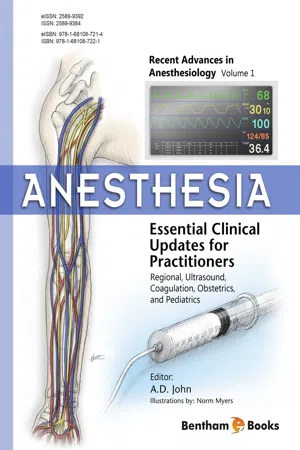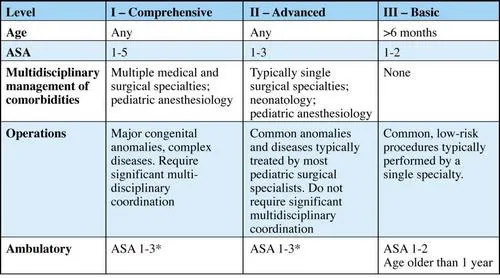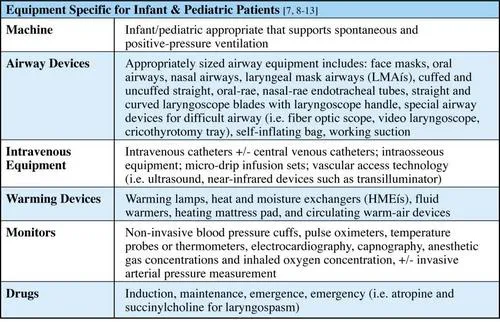
eBook - ePub
Anesthesia: Essential Clinical Updates for Practitioners – Regional, Ultrasound, Coagulation, Obstetrics and Pediatrics
- English
- ePUB (mobile friendly)
- Available on iOS & Android
eBook - ePub
Anesthesia: Essential Clinical Updates for Practitioners – Regional, Ultrasound, Coagulation, Obstetrics and Pediatrics
About this book
This book provides a quick update on key aspects of current anesthesia practice. Book chapters are written in a concise manner to enable readers anesthesia providers and medical students to quickly refresh their knowledge, and understand the essential p
Frequently asked questions
Yes, you can cancel anytime from the Subscription tab in your account settings on the Perlego website. Your subscription will stay active until the end of your current billing period. Learn how to cancel your subscription.
At the moment all of our mobile-responsive ePub books are available to download via the app. Most of our PDFs are also available to download and we're working on making the final remaining ones downloadable now. Learn more here.
Perlego offers two plans: Essential and Complete
- Essential is ideal for learners and professionals who enjoy exploring a wide range of subjects. Access the Essential Library with 800,000+ trusted titles and best-sellers across business, personal growth, and the humanities. Includes unlimited reading time and Standard Read Aloud voice.
- Complete: Perfect for advanced learners and researchers needing full, unrestricted access. Unlock 1.4M+ books across hundreds of subjects, including academic and specialized titles. The Complete Plan also includes advanced features like Premium Read Aloud and Research Assistant.
We are an online textbook subscription service, where you can get access to an entire online library for less than the price of a single book per month. With over 1 million books across 1000+ topics, we’ve got you covered! Learn more here.
Look out for the read-aloud symbol on your next book to see if you can listen to it. The read-aloud tool reads text aloud for you, highlighting the text as it is being read. You can pause it, speed it up and slow it down. Learn more here.
Yes! You can use the Perlego app on both iOS or Android devices to read anytime, anywhere — even offline. Perfect for commutes or when you’re on the go.
Please note we cannot support devices running on iOS 13 and Android 7 or earlier. Learn more about using the app.
Please note we cannot support devices running on iOS 13 and Android 7 or earlier. Learn more about using the app.
Yes, you can access Anesthesia: Essential Clinical Updates for Practitioners – Regional, Ultrasound, Coagulation, Obstetrics and Pediatrics by Amballur D. John in PDF and/or ePUB format, as well as other popular books in Medicine & Anesthesiology & Pain Management. We have over one million books available in our catalogue for you to explore.
Information
Pediatric Anesthesia
Monica Hoagland, Tessa Mandler, Lawrence I. Schwartz*
Colorado Children’s Hospital, Aurora, CO, USA
Abstract
CHILDREN ARE NOT SMALL ADULTS. In this chapter, we will discuss the resources and standards that must be in place, in order for community-based programs to be in a position to deliver quality anesthetic care to children. Patient and procedural selection policies, appropriate equipment, dedicated physical space, and knowledgeable and experienced providers are just some of what is required. Caring for children in a large children’s hospital, where the entire system is geared toward pediatrics, can test the most experienced pediatric anesthesiologist. Children have unique physiologic, pharmacologic, pathophysiology, and behavioral characteristics which change and develop throughout their lives. We will examine the pre-operative, intra-operative, and post-operative aspects that make pediatric anesthesia different from the perioperative care of adults. Additionally, we will provide an overview of the anesthetic management of some of the more common ambulatory pediatric procedures which may be encountered in the community-based practice such as; myringotomy and tympanostomy tube insertion; tonsillectomy and adenoidectomy; genitourinary procedures – circumcision, hypospadias repair, inguinal hernia repair, and orchiopexy; and foreign body removal.
Keywords: Adenoidectomy, Bronchospasm, Children, Circumcision, Difficult pediatric airway, Foreign body removal, Hypospadial repair, Infants, Inguinal hernia, Laryngospasm, Myringotomy, Neonates, Orchiopexy, Pediatric anesthesia, Pediatric intraoperative fluid management, Pediatric surgery, Pediatric pain medication, Pediatric postoperative nausea and vomiting, PRAE (perioperative respiratory delirium), Postoperative pediatric pain control, Tonsillectomy, Tympanostomy.
* Corresponding author Lawrence I. Schwartz: Colorado Children’s Hospital, Aurora, CO, USA; Tel: 720-777-4999; Fax: 720-777-7266; E-mail: [email protected]
INTRODUCTION
Children are not small adults. Pediatric patients greatly vary from 1000 gram premature infants to the morbidly obese adolescents, and each one presents a special set of challenges to the anesthesiologists who care for them.
These patients have unique physiologic, pharmacologic, pathophysiology, and behavioral characteristics which change and develop throughout their lives. Caring for children in a large children’s hospital, where the entire system is geared toward pediatrics, can test the most experienced pediatric anesthesiologist. When these patients present to community based centers, with fewer resources and personnel focused on children, these challenges can be overwhelming and possibly compromise safe, quality pediatric anesthesia.
In this chapter, we will discuss the resources and standards that must be in place, in order for community-based programs to be in a position to deliver quality anesthetic care to children. Patient and procedural selection policies, appropriate equipment, dedicated physical space, and knowledgeable and experienced providers, are just some of what is required of institutions which desire to care for pediatric anesthesia patients. We will examine the pre-operative, intra-operative, and post-operative aspects that make pediatric anesthesia different from the perioperative care of adults. Additionally, we will provide an overview of the anesthetic management of some of the more common ambulatory pediatric procedures which may be encountered in the community based practice.
PATIENT AND PROCEDURE SELECTION
Current evidence has established that some children have a higher risk of perioperative morbidity and mortality. Specifically, neonates, critically ill children, and children with complex comorbidities may benefit from care delivered in specialized hospitals. However, historically, American Society of Anesthesiologists (ASA) classification 1 and 2 children have been safely cared for in community based hospitals and surgical centers. Community-based centers caring for children must develop, administer, and maintain a system that allows for the “correct” pediatric patients to be anesthetized by a dedicated group of anesthesia and surgical providers focused on providing safe and effective care for pediatric patients.
Routine pediatric surgeries are performed in several types of institutions (i.e. children’s hospitals, adult hospitals, ambulatory surgery centers, etc.). The vast majority of pediatric surgical procedures are completed in an outpatient setting with an increasing number occurring in freestanding locations [1, 2]. Table 1 lists the most common Ambulatory procedures on patients younger than 15 years of age.
Table 1 Most common inpatient pediatric surgery procedures on pstients <15 years of age. Adapted from Centers for Disease Control and Prevention. National Survey of Ambulatory Surgery [3]. Provided by Drs. Monica Hoagland, M.D., Tessa Mandler, M.D., Lawrence I. Schwartz, M.D., Colorado Children’s Hospital.
 |
Despite the establishment and maturation of pediatric surgery as a subspecialty, approximately 40% of the most common pediatric inpatient surgical procedures are performed in non-pediatric hospitals [4]. However, complex pediatric surgeries are 6-16 times more common in a pediatric hospital than any other institution [5]. Table 2 lists the most common inpatient pediatric surgery procedures.
In 2014, a Task Force for Children’s Surgical Care established guidelines for providing a “surgical and anesthetizing” level of care to pediatric patients undergoing surgical procedures. The purpose of center classification was to assure optimal resources to care for infants and children undergoing surgical intervention and to define the procedures and patients that are within the typical scope of practice of each level [6]. A summary of the Children’s Surgical Center Standard and Scope of Practice are reviewed in Table 3.
These recommendations have been endorsed by the board of the Society for Pediatric Anesthesia (SPA) and the American College of Surgeons (ACS). How these standards will impact pediatric care remains to be seen. Suffice it to say, that the needs to anesthetize children in community-based settings is only increasing and will require greater cooperative planning to facilitate safe and effective regional care.
Table 2 Most Common Inpatient Pediatric Surgery Procedures (Modified from Somme [5]). Provided by Drs. Monica Hoagland, M.D., Tessa Mandler, M.D., Lawrence I. Schwartz, M.D., Colorado Children’s Hospital.
 |
Table 3 A summary of the children’s surgical center standard and scope of practice.
 |
Resources Necessary for the Perioperative Care of Children
Table 4 Equipment Specific for Infant & Pediatric Patients [7-13]. Provided by Drs. Monica Hoagland, M.D., Tessa Mandler, M.D., Lawrence I. Schwartz, M.D., Colorado Children’s Hospital.
 |
Equipment
Prior to anesthetizing an infant or child, a comprehensive selection of pediatric equipment that is regularly stocked and maintained must be readily available to the anesthesiology care team (Table 4). Airway equipment and intravenous catheters are manufactured in various sizes to meet the needs of children of all ages. In addition, emergency drugs and equipment including, a code cart with pediatric defibrillator pads and medications for resuscitation and malignant hyperthermia, and a difficult airway cart all need to be immediately accessible [7, 8]. Resuscitation drugs should be stocked in appropriate infant/pediatric concentrations. Furthermore, even if the entire perioperative staff is well educated on pediatric emergency drug dosing and administration, it is prudent to have a clearly written pediatric dose schedule for these drugs easily accessible [8, 9].
Monitors
Vigilant monitoring of patients under anesthesia significantly improves perioperative morbidity and mortality. While properly trained, expe...
Table of contents
- Welcome
- Table of Contents
- Title
- BENTHAM SCIENCE PUBLISHERS LTD.
- PREFACE
- DEDICATION
- List of Contributors
- Trauma
- Upper Extremity Blocks
- Paravertebral Block
- Lower Extremity Blocks
- Vascular Access
- Bleeding and Clotting: Blood and Drugs
- Anesthesia for Obstetrical Emergencies
- Pediatric Anesthesia
- Pediatric Trauma